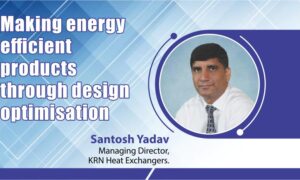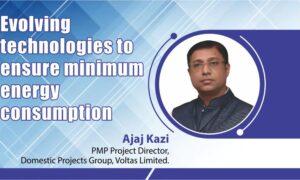“India has had and is still having a successful green building movement.”
HVAC in green building is a broad topic, and if put it together, it’s evolving HVAC solutions in green world. Green is a subject that we have been talking about; we’ve been hearing about for nearly last two decades. India has had and is still having a successful green building movement. We are today pioneering in the world.
Green building movement
In terms of the green footprint, we are way ahead of most of the countries and we are marching a way to be number one, the largest footprint on or in a short while from now; maybe a few years from now. Where does the need for the green buildings comes in, I think, we all know the environmental footprint, which a man leaves behind is quite distinct, disruptive and creates challenges for other people, other species in the world. Compared to anybody else, we have the largest footprint. If the Mother Earth could speak to us, this is what we will be told we are stupid. Water and air – which are the two essential elements on which the entire life species hinge upon it. In this context, the green buildings have played an important role. They have brought out the importance of the subject.
IEQ, Energy efficiency and rating
In most of the cases, the green is also associated with energy efficiency. If you look at the rating systems, what evolved in last two decades, the focus continues to be on energy efficiency. And today, it has moved to indoor environmental quality. Both energy efficiency as well as the indoor environmental quality primarily hinge around the air conditioning systems. If you look at any building, if you look at the energy bill of any building, the air conditioning is the main culprit for the high bills. And, that is where a lot of time the green is often misunderstood as something to do with energy efficiency alone.
Nearly 40 to 50 percentage of the total rating system hinges on energy and the indoor environmental quality. The HVAC systems in last two decades have evolved. 30 years back, there was nothing as efficiency or concerns of our indoor environment. It’s all about the subjects, the green buildings have helped us; the whole movement has helped us to improve the equipment efficiencies. Today, we talk of I-2; I-3 I-4 motors, we are talking about the most efficient fans, we are talking about anything that we say, we look at the equipment efficiency, again primarily on the HVAC front. No other discipline in the building has evolved to an extent, what the air conditioning systems has done.
We are talking about green refrigerants, the global warming. Gone are the days of CFCs HFCs, HCFCs, now, we are talking about HFO. The indoor design conditions are being challenged world over the government is coming out with the guidelines on higher indoor temperatures, better indoor environment quality and India is no different where the government of India has put up a requirement for 24 degree C indoor temperatures.
The thermal comfort has become a new subject. In the past we could never talk about what we say in mixed mode ventilation, we could never talk about or enhanced air movement, relative humidity. Now the thermal comfort is another criterion that we are saying is important with respect to comfort indoor air quality. Today, India enjoys world class products available from manufacturers all over the world. The make-in-India program and Atmanirbharta is also bringing the manufacturing to India, which we are seeing and type of products that we are having. And lastly, it has also brought in the equipment certification, we could never think about AHRI or Eurovent. Indian certification is done for the products that we use are for HVAC and energy efficiency. Today, when we look at these, we are at par with the global standards.
In fact, today we are talking the air conditioning, electrical, plumbing, fire, everything 1/7th of what we used to do this two decades back. The air conditioning itself has played the most important role here. So, all of this has been an outcome in building movement.
So, as rightly mentioned about the indoor environmental quality, the air is becoming an area of concern. People are turning to buildings for solution, because we spend 90 to 95 percent of time indoors. ISHRAE came out with the IAQ standard in 2016 recognising the need for it, and if you look at the subjects that was covered by the IEQ, standard – thermal comfort, indoor air quality or acoustics, all of them related again to the air conditioning system.
IGBC and IAQ standards
And, today our designs, our solutions have to look at that as a natural corollary. The rating systems from the US Green Building Council, Indian green building councils are talking about the wellness and it is all about the wellness of the people and site.
IGBC health and wellness wellbeing rating system may issue a IAQ standard as a base standard. COVID-19 again, emphasises the need for good indoor environment. And it all talked about going back to the basics of the HVAC design. HVAC systems are the ones which are expected to solve the problem for providing a safe indoor environment to the people. Today, the world is now moving on to what we call digital twins. But digital twinning is all about creating a mirror of the building on a computer simulation tool; without before you even physically construct it or do anything to it. So, you have a digital twin, which is available, you can play with that, wherein you can optimise the building design, whether it’s a Greenfield project or a brownfield project.
IoT – another big emerging area
And all of this digital tooling and IoT is expected to change the way we design and where we construct the buildings or the air conditioning systems. ISHRAE recognising this importance is coming out with a building energy performance standard, to benchmark the energy performance. Now, if you look at the current ECBC, or the ASHRAE, 90.1, they all talk about energy efficiency. But we don’t know how the subsystems in that building are performing. What is the individual HVAC system performance? What is the individual plumbing system performance? What is the individual elevator performance? What should it be, what should the benchmark be!
Net zero and carbon neutrality perspective green standards that we follow, is now all going to be about performance. The focus will shift from design to actual operation of the buildings. The trends in the market today are, the green rating is something that we have done for two decades; and we are doing it. But we are now moving to what we call a net zero world. Net zero in terms of energy, net zero in terms of water, net zero in terms of waste, all three areas; again, in HVAC systems, the air conditioning systems play the role.
Moving forward to sustainability
Energy-water Nexus is another area that we are discussing. And that’s where how the energy can be cut down to reduce the water demand. And, how can the water demand reduction, help that energy reduction! That’s another area, being talked about.
Finally, the move is on to low carbon world carbon neutral world, which is the ultimate aim. Already, the cities and the countries are putting a guideline that 2030 is the start of the carbon neutral era. And hopefully in another decade, two decades after that, the whole world will be moving towards that, once again. HVAC would be the focus. I personally foresee this as what the future specifications will read line. I think, whether it’s water, energy, waste, ratings, everything is going to be zero. And once you reach that zero, you’ve actually made the world more sustainable. So, it’s the steps that we are taking.
I know that we in India are marching ahead, moving forward. We need to continue thinking big, we need to dream big. And believe me, in India it is happening and it will happen. We would be the leaders in the net zero movement also. And that’s where it’ll be true sustainability.
Cookie Consent
We use cookies to personalize your experience. By continuing to visit this website you agree to our Terms & Conditions, Privacy Policy and Cookie Policy.















